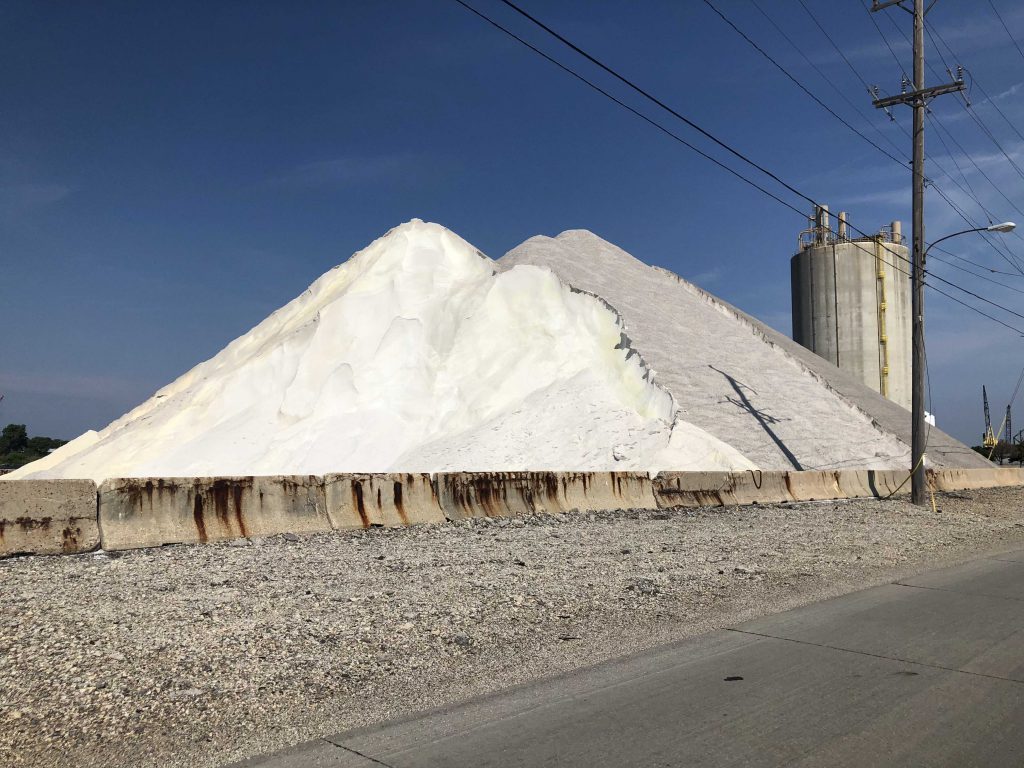Cities Search for Road Salt Alternatives
Over past decade communities in Milwaukee County have used 700,000 tons of salt.
Southeastern Wisconsin has seen a mild winter. But it’s only January, and Wisconsin communities are preparing by looking at alternatives to road salt.
While salt has been an effective way to melt ice on roads and sidewalks, as little as one teaspoon permanently pollutes five gallons of water, according to the state Department of Natural Resources.
Over the past decade, the communities that make up Milwaukee County used about 18.3 billion teaspoons — or around 320,000 tons of salt. County highway and freeway usage in Milwaukee County contributed to another 380,000 tons of salt being used over the last decade.
That salt goes into ground water, rivers and Lake Michigan, according to the DNR.
Many Wisconsin communities have begun using brine, a highly concentrated water solution of common salt (sodium chloride).
Brine keeps snow from sticking to the road, and in the end, uses much less sodium chloride. Brine also keeps snow and ice from binding to the pavement so it’s easier to plow, and it’s more targeted than dropping rock salt.
During the 2013-2014 season, the city of Cudahy used 17.8 tons of salt per snow event, according to a case study by the DNR. For the 2016-2017 season, the city applied brine to all streets, parking lots and city-maintained sidewalks.
For the last two seasons, Cudahy reduced its salt use to 13.9 tons per event, according to the case study. Doing so saved the city a total of $40,602, according to the DNR.
Cudahy is about 5 square miles with a population of 18,600 people.
Nearby, the city of Oak Creek just spent about $160,000 on a salt brine system.
Oak Creek Mayor Dan Bukiewicz said he’s hoping the equipment pays for itself in two to three years, since brine reduces salt use by about 33 percent.
The city of Milwaukee has considered an alternative to salt, but cannot agree on a solution, said Alder Robert Bauman, who chairs the public works committee.
“The big issue is cost,” Bauman said. “Salt is inexpensive. I have argued we should look at the full cost of salt use — including corrosion and pollution, to no avail.”
The City of Madison salts about half of its streets — bus routes, major roads and streets near schools and hospitals. The city also uses brine to pre-treat some roads before winter storms. Dane County manages its state highways with brine before winter storms.
Barrilleaux said while there is a lot of talk about roads, about half of the salt used is spread on parking lots, sidewalks and driveways. Barrilleaux said sand is a much better alternative.
“We’ve been working very hard to educate both public and private winter maintenance crews about how to avoid salt overuse,” Barrilleaux said. “If you walk around a parking lot in the winter and it is white with salt, that is much more than is needed for ice.”
Wisconsin Communities Search For Road Salt Alternatives was originally published by Wisconsin Public Radio.























Salt is one more reason how railroads are more environmentally friendly than highways.
Railroads never use salt because they simply don’t need it (not to mention the fact that salt would damage steel rails). When tracks get icy, trains have “sandboxes” that sprinkle a tiny amount of sand directly on tracks providing traction. No sand is dispensed between or outside the rails.
A 12-foot highway lane typically is salted for its entire width—a 12-foot wide band of polluting salt (plus additional salt used on shoulders). A railroad track (with higher capacity than a highway lane) only gets two narrow (less than 2 inches each) stripes of non-polluting sand.
Part of the problem is that very many Wisconsinites have come to expect that, within hours of a major snowstorm, they should be able to get in their cars and drive wherever they want, as fast as usual, rather than recognizing that when there is a snowstorm, it is necessary to slow down, to drive only when necessary, and to take into account weather and road conditions. Ignoring that leads to tremendous pressure on local and state officials to agree to excessive and indiscriminate use of salt, with dire results for the quality of our waterways and lakes — and for the well-being of fish and wildlife.